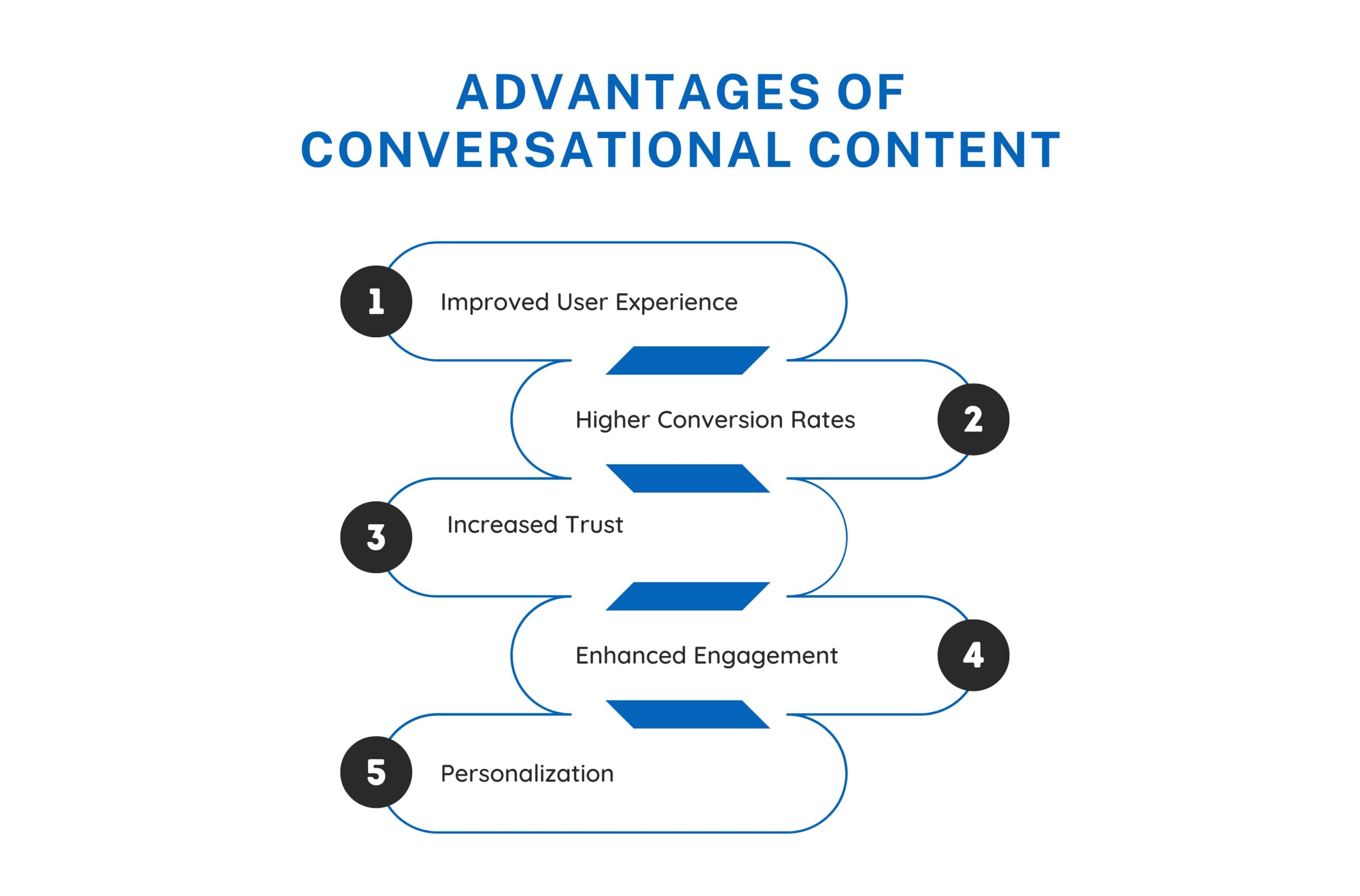In online communication, one trend stands out for its ability to captivate and engage audiences: conversational content. As traditional marketing strategies give way to more personalized and interactive approaches, businesses are discovering the remarkable potential of crafting content that resonates with users as if they were engaged in a genuine conversation.
Contents
- 1 What is a Conversational Content?
- 2 Advantages of Conversational Content
- 3 The Shift Towards Conversational Content
- 4 Engagement through Interaction
- 5 Addressing User Needs through Conversations
- 6 Challenges and Considerations
- 7 Conclusion
- 8 Frequently Asked Questions (FAQs)
- 8.1 1. What is Conversational Content?
- 8.2 2. What type of content can be considered conversational?
- 8.3 3. How does conversational content differ from traditional content?
- 8.4 4. What are the benefits of using conversational content in customer support?
- 8.5 5. What are some tools and platforms for creating conversational content?
- 8.6 6. What’s the future of conversational content?
What is a Conversational Content?
Conversational content refers to digital content that is designed and written in a way that mirrors natural human conversation. It involves using a more casual and approachable tone to engage the audience as if they were participating in a real conversation. This type of content often involves addressing the reader directly, asking questions, and using language that is relatable and easy to understand.
Conversational content can be found in various forms such as blog posts, social media updates, email marketing campaigns, chatbot interactions, and even website copy. The goal of conversational content is to create a sense of authenticity and connection between the brand or content creator and the audience. It aims to capture the way people communicate in everyday life, fostering a more relatable and engaging experience.
Advantages of Conversational Content
1. Improved User Experience:
Conversational content can provide immediate answers to users’ questions, helping them to find the information they need quickly. This can enhance the overall user experience, making it more efficient and satisfying.
2. Higher Conversion Rates:
When users feel like they are having a genuine conversation with the brand, they are more likely to be influenced by the content and take desired actions, such as making a purchase or signing up for a service.
3. Increased Trust:
A conversational approach creates an impression that the brand is genuinely interested in engaging with its audience. This transparency and responsiveness contribute to building trust and credibility.
4. Enhanced Engagement:
Conversational content encourages users to actively participate and respond, leading to higher levels of engagement. When content feels like a dialogue, users are more likely to comment, share, and interact with the brand.
5. Personalization:
Conversational content allows brands to tailor messages to specific audience segments or individual users. This personalization helps create content that is more relevant to the reader’s interests and needs.
The Shift Towards Conversational Content
The rise of social media, messaging apps, and voice-activated devices has transformed the way people communicate. This shift is not just about the tools we use but also about the way we engage. Businesses are recognizing that adopting a conversational tone in their content can establish a more authentic and relatable connection with their target audience.
Conversational content encompasses various formats, from blog posts and social media updates to email marketing and chatbots. It’s about crafting content that feels less like a sales pitch and more like a friendly dialogue.
Engagement through Interaction
Traditional one-way communication is giving way to interactive experiences, and conversational content is at the forefront of this shift. Polls, quizzes, surveys, and interactive videos are all examples of content that encourages users to participate actively. By involving users in a conversation rather than simply delivering information, brands can create a more memorable and impactful experience.
Interactive content not only boosts engagement but also provides valuable insights into user preferences and behaviors. This data can inform future content strategies and help tailor offerings to better match audience needs.
Addressing User Needs through Conversations
Conversational content is not just about being chatty; it’s about listening to your audience and addressing their needs. Social media platforms and comment sections offer avenues for users to voice their opinions, ask questions, and seek assistance. Brands that actively engage in these conversations showcase their commitment to customer satisfaction.
Additionally, leveraging conversational AI, such as chatbots, can enhance user experiences. Chatbots can provide instant responses to common queries, guide users through processes, and even offer product recommendations. This immediate assistance not only improves user satisfaction but also contributes to the brand’s reputation for excellent customer service.
Challenges and Considerations
While the benefits of conversational content are evident, it’s important to approach this strategy with care. Achieving a conversational tone that doesn’t come across as forced or insincere can be challenging. Striking the right balance between casual conversations and maintaining a professional image is key.
Furthermore, as AI-driven chatbots become more prevalent, it’s essential to ensure that the user experience remains positive. While chatbots can handle routine queries, they should seamlessly transition to human support when a situation demands it.
Conclusion
Conversational content is more than a trend; it’s a paradigm shift in how brands engage with their audiences. By infusing a human touch, fostering authentic connections, and embracing interactive experiences, businesses can create meaningful conversations that resonate with users.
The power of conversation will remain at the heart of successful content strategies, forging stronger bonds between brands and their valued customers.
Frequently Asked Questions (FAQs)
1. What is Conversational Content?
Conversational content refers to written or spoken material designed to engage and interact with an audience in a natural, conversation-like manner. It often aims to mimic human conversation through text or speech.
2. What type of content can be considered conversational?
Conversational content can take various forms, including chatbots, social media posts, blog article written in a conversational tone, podcasts, and interactive videos.
3. How does conversational content differ from traditional content?
Traditional content tends to be more formal and one-sided, while conversational content is interactive, and informal, and often invites audience participation or responses.
4. What are the benefits of using conversational content in customer support?
Conversational content in customer support can provide quicker and more personalized assistance, reduce customer frustration, and offer a more human touch to the support experience.
5. What are some tools and platforms for creating conversational content?
Tools like chatbot platforms, social media management tools, and content management systems (CMS) often include features for creating and managing conversational content.
6. What’s the future of conversational content?
The future likely involves even more sophisticated AI-driven interactions, seamless integrations across platforms, and increased personalization to enhance user experiences.



